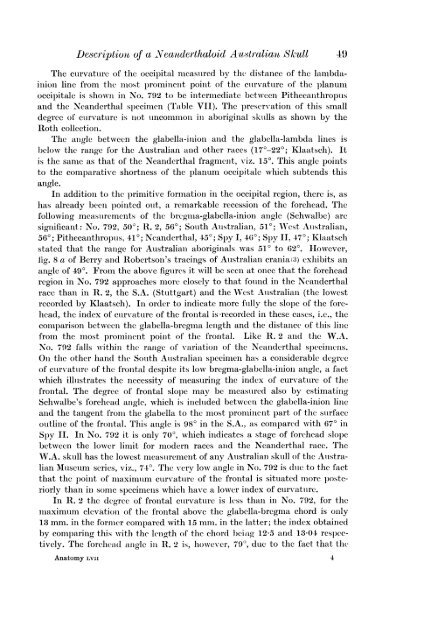THE DESCRIPTION OF A NEANDERTHALOID AUSTRA-
THE DESCRIPTION OF A NEANDERTHALOID AUSTRA-
THE DESCRIPTION OF A NEANDERTHALOID AUSTRA-
You also want an ePaper? Increase the reach of your titles
YUMPU automatically turns print PDFs into web optimized ePapers that Google loves.
Description of a Veanderthaloid Australian, Skull 49<br />
The curvature of the occipital measured by the distance of the lambdainion<br />
line from the most prominent point of the curvature of the l)lanum<br />
occil)itale is shown in No. 792 to be intermediate between Pithecanthroplus<br />
and the Neanderthal spccimecn (Table VII). The preservation of this small<br />
degree of curvature is not uncommon, in aboriginal skulls as showni by the<br />
Roth collection.<br />
The angle between the glabella-inion and the glabella-lambda lines is<br />
below the range for the Australian and other races (17°-22°; Klaatsch). It<br />
is the same as that of the Neanderthal fragment, viz. 150. This angle points<br />
to the comparative shortness of the planum occipitale which subtends this<br />
angle.<br />
In addition to the l)rimitive formation in the occipital region, there is, as<br />
has already been. )ointed out, a remnarkable recession of the forehead. The<br />
following measurements of the bregma-glabella-inion angle (Schwalbe) are<br />
significant: No. 792, 5()°; R. 2, 56°; South Australian, 51°; West Auistraliain,<br />
560; Pithecantthropuis, 41°; Neanderthal, 450; Spy I, 46°; Spy II, 470; Klaatsch<br />
stated that the range for Australian aboriginals was 510 to 62'. However,<br />
fig. 8 a of Berry and Robertson's tracings of Australian crania(3) exhibits an<br />
angle of 49'. From the above figures it will be seen at once that the forehead<br />
region in No. 792 approaches more closely to that found in the Neanderthal<br />
race than. in R. 2, the S.A. (Stuttgart) and the West Australian (the lowest<br />
recorded by Klaatsch). In order to indicate more fully the slope of the forehead,<br />
the index of curxvature of the frontal is recorded in these cases, i.e., the<br />
comparison between the glabella-bregma length and the distance of this line<br />
from the most proImninent point of the frontal. Like R. 2 and the W.A.<br />
No. 792 falls within the range of variation of the Neanderthal speciniciis.<br />
On the other hand the South Auistralian specimen, has a considerable degree<br />
of curvature of the frontal despite its low bregma-glabella-inion. angle, a fact<br />
which illustrates the necessity of measuring the index of curvature of the<br />
frontal. The degree of frontal slope may be measured also by estimating<br />
Schwalbe's forehead angle, which is included between the glabella-inion lihe<br />
andl the tangent fronm the glabella to the most prominent part of the surfacec<br />
outline of the frontal. This angle is 98° in the S.A., as compared with 67° in<br />
Spy II. In No. 792 it is only 70°, which indicates a stage of forehead slope<br />
between the lower limit for modern races and the Neanderthal race. The<br />
W.A. skull has the lowest measurement of any Australian skull of the Australian.<br />
Museum series, viz., 74'. The very low angle in No. 792 is dute to the fact<br />
that the point of maximum curvature of the frontal is situated morc posteriorly<br />
than in some specimens which have a lower index of curvatture.<br />
InI R. 2 the degree of frontal curvature is less than in No. 792, for the<br />
maximum elevation. of the frontal above the glabella-bregma chord is only<br />
13 mm. in the former compared with 15 mm. in the latter; the index obtained<br />
by complaring this with the lenogth of the chord being 12-5 and 13-04 res)ectively.<br />
The forehead anoglc in R. 2 is, lioNvever, 790, due to the fact that thc<br />
Anatomy LVII 4

















